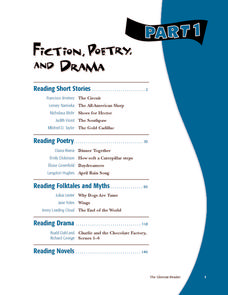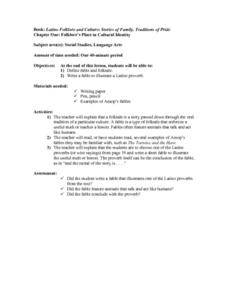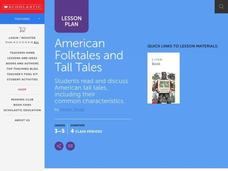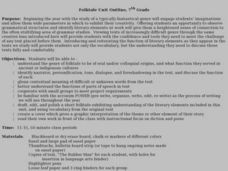Scholastic
Folk and Fairy Tale Readers: The Spider and the Beehive
Anansi the spider teaches young readers the importance of sharing with others in this fun African folktale. Offering clear illustrations and repetitive structure, this printable book is ideal for developing children's reading fluency.
Curated OER
Myth Lesson Plans
What is the difference between myths, legends, and folktales? From greek mythology and creation myths to heroes and heroines, here is a nice series of lessons for providing your kids with solid foundational knowledge about myths.
Curated OER
Fiction, Poetry, and Drama Part 1
Similar to a textbook, this resource includes multiple texts, plenty of explanation, lots of practice, and several graphic organizers. Use all of the materials, or pick and choose from such texts as "The Circuit," "Shoes for Hector,"...
Curated OER
Build Listening Skills With Asian Folktales
Young scholars read five folktales. After each folktale is read students use a map to find the location of the country of the tale's origin. Next, young scholars answer comprehension questions related to each folktale.
Curated OER
"Weighing the Elephant"
Can your class solve the problem presented in the Chinese folktale, "Weighing the Elephant?" Read your class the description before having them attempt to solve the problem. After they've come up with an answer (or attempted to!), finish...
Curated OER
CTBS Reading Practice #2
This is a basic reading comprehension practice worksheet. Learners read 3 passages: folktale, Richard Cory, and an informational text about the Roosevelts. They then answer multiple choice questions that test reading comprehension. Some...
Curated OER
Literary Elements and Vocabulary: Mini Quiz
Readers match five literary terms -- personification, narrator, tone, dialogue, foreshadowing -- with their definitions. They also spell, identify the part of speech, define, and write a creative sentence for each of five...
Curated OER
The Ogre Bully
First graders complete activities with the story The Ogre Bully. In this literature lesson plan, 1st graders discuss opposite words and then read the story. They answer questions for comprehension and complete phonics activities and...
Curated OER
Rooster's Night Out
Students explore folktales. In this folktale lesson, students listen to a story from another country and discuss the characters. Students retell the story using puppets and do coloring sheets. Students do a sequencing cut and paste...
Curated OER
Stories of Hope: Dragonfly and Mosquito
Students identify and interpret the value of the dragonfly as a predator of the mosquito. They create their own folktales using the dragonfly or a creature of their choice to solve the malaria problem or another issue. Students also...
Curated OER
Latino Folklore and Culture: Stories of Family, Traditions of Pride
Students define the terms fable and folktale. They write a fable to illustrate a Latino proverb. Students are explained that a folktale is a story passed down through the oral tradition of a particular culture. A fable is a type of...
Curated OER
Writing for Advanced ESL Learners
Students complete many creative writing assignments in their advanced ESL class. In this creative writing lesson plan, students complete book reports, folktales, biographies, historical journal entries, and more.
Curated OER
African Folktales Lesson
Students explore what a folktale consists of as it relates to oral tradition. For this folktale lesson, students are told the African folktale, Why the Sun is Lives in the Sky and make personal inferences about what the folktale is...
Curated OER
What was the lesson learned in the story, "One Grain of Rice?"
Second graders complete activities with the folktale "One Grain of Rice." In this folktale lesson, 2nd graders discuss the lesson learned in the story. They also tell character traits of the main character Rani.
Curated OER
American Folktales and Tall Tales
Students explore the elements of American folktales. They discuss how they are passed on from generation to generation, how they use exaggeration, and how they convey a message or make a point. Students identify common elements of tall...
Curated OER
Why Mosquitoes Buzz in People's Ears
Second graders study folktales and their characteristics. After brainstorming what they know about Africa, 2nd graders read a book about mosquitoes. In groups, students develop a graphic organizer about the characteristics of the...
Curated OER
Goldilock and the Three Bears
Students explore folktales. They create artwork that represents the setting, charactes, and key events of the story. Working collaboratively, students assemble their own artwork to create a class mural. Working collaboratively,...
Curated OER
Storytelling
Students explore the origins of folktales, fairytales, myths, legends, fables, and folktales in the ten lessons of this unit. A storytelling festival is held to feature the results of the variety of activities presented in the unit.
Curated OER
Folktale Unit Outline
Seventh graders analyze grammatical structures and identify literary elements in a variety of texts. Through the genre of folktales, ancient or indigenous cultures are studied.
Curated OER
Narratives in the Simple Past
Students recognize the simple past forms in a folktale. They supply some of these forms when asked
Curated OER
Literature
Students listen and respond to poems about rain. Then they review the continent of Asia and the country of Japan. They listen to a Japanese folktale about a peach boy. Next they listen to a story from Germany about musicians.
Curated OER
An African Folktale
Students learn what a folktale is and illustrate their favorite part of the story The Orphan Boy. They also write a folk story that explains a natural phenomena.
Curated OER
Summarizing Key Information
Students summarize information. For this language arts lesson, students summarize information from a fictional text. Students read a folktale and summarize the story.
Curated OER
"The Three Billy Goats Gruff"
Studnets spread out in space provided. They are given two rules: no sounds, no touching. Pupils begin with the leader says, "Go," students move; when the leader says "Stop," they freeze. Students work individually and simultaneously,...

























